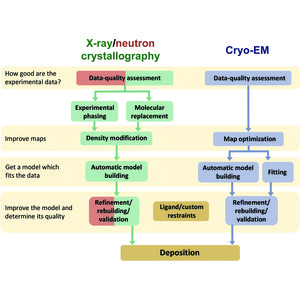

In recent years, initial construction of the protein chain has often been carried out using automatic model-building tools such as ARP/ wARP (Langer et al., 2008 ▶), SOLVE/ RESOLVE (Wang et al., 2004 ▶) and more recently Buccaneer (Cowtan, 2006 ▶). Coot is an interactive three-dimensional molecular-modelling program particularly designed for the building and validation of protein structures by facilitating the steps of the process. Macromolecular model building using X-ray data is an interactive task involving the iterative application of various optimization algorithms with evaluation of the model and interpretation of the electron density by the scientist. The current state of the software is presented, with a description of the facilities available and of some of the underlying methods employed. The software is under rapid development, but has already achieved very widespread use within the crystallographic community. Recent developments have focused on providing tools for expert users, with customisable key bindings, extensions and an extensive scripting interface. The software is designed to be easy to learn for novice users, which is achieved by ensuring that tools for common tasks are ‘discoverable’ through familiar user-interface elements (menus and toolbars) or by intuitive behaviour (mouse controls). Furthermore, tools are provided for model validation as well as interfaces to external programs for refinement, validation and graphics.
#Cite coot software manual#
The program displays electron-density maps and atomic models and allows model manipulations such as idealization, real-space refinement, manual rotation/translation, rigid-body fitting, ligand search, solvation, mutations, rotamers and Ramachandran idealization.

Coot is a molecular-graphics application for model building and validation of biological macromolecules.


 0 kommentar(er)
0 kommentar(er)
